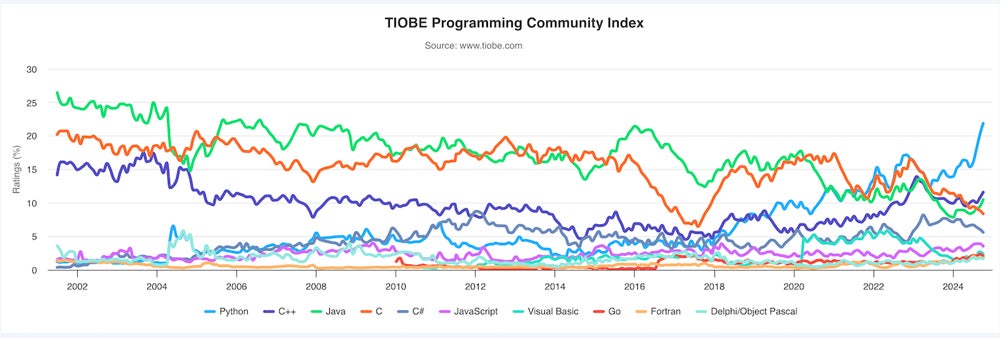TIOBE Programming Index Update: October 2024 - A New Contender Emerges
The programming landscape is ever-evolving, with new languages vying for attention and established ones fighting to maintain their dominance. This month’s TIOBE Programming Index has brought some significant shifts worth discussing, especially for developers keen to stay ahead. I’m particularly fascinated by the rise of Mojo, a language that has swiftly grabbed a spot in the top 50 within just a year of its introduction.
 Programming Languages Evolution
Programming Languages Evolution
Python: The Unwavering Leader
Despite whispers about its speed limitations, Python continues to reign supreme, climbing from 20.17% in September to a noteworthy 21.9% in October. This uptick only solidifies its position as the go-to language for many developers. Its versatility and ease of learning make it a favorite among newcomers and seasoned professionals alike. I remember my own journey into programming—Python was my entry point, and I’ve found its syntax to be both intuitive and forgiving. In a world where every second counts, that can make all the difference.
In second place, C++ has seen a modest rise from 10.75% to 11.6%. Java follows closely, increasing from 9.45% to 10.51%. These statistics reflect more than just numbers; they embody the evolution of programming itself and the community’s shifting preferences. With the rise of data-heavy applications, the demand for robust, high-speed languages is more critical than ever.
Exploring Alternatives: Rust’s Rise
While Python remains an outstanding choice, there’s an undercurrent of frustration among developers regarding its execution speed. This has fueled interest in alternatives, particularly Rust, which has garnered attention for its safety features and performance. Rust’s ability to provide memory safety without sacrificing speed aligns perfectly with what many in the programming community are searching for. As someone who has dabbled in Rust, I can vouch for its elegance and power—a real game-changer for modern software development. I wouldn’t be surprised to see Rust creeping into the TIOBE Index top 10 soon.
Mojo Language: A New Challenger
The real surprise of this month’s TIOBE Index is Mojo—a language that has made a remarkable debut by entering the top 50 after just a year in existence. Developed by Chris Lattner at Modular, Inc., Mojo distinguishes itself with a focus on performance and an easy learning curve. Being both a programmer and a lifelong learner, I am intrigued by what Mojo promises. It appears to combine the best of both worlds: the ease of Python with the performance typical of lower-level languages.
As a developer, I often find myself torn between the desire for speed and the need for simplicity. The emergence of Mojo resonates with this ongoing struggle, providing a potential solution for those of us craving a language that balances usability with powerful capabilities. The tech community is abuzz with excitement, and I find myself swept up in that enthusiasm.
Conclusion
As we navigate through this increasingly complex digital landscape, the programming languages we choose to adopt can significantly impact our projects. Python will likely continue to shine, but languages like Rust and Mojo are poised for their moment in the spotlight, and it will be fascinating to see how the TIOBE Index reflects these changes in the coming months.
For language enthusiasts and developers craving the latest insights, I’d recommend following the TIOBE Programming Community Index closely. It not only tracks trending languages but also serves as a litmus test for our evolving needs in the programming world. Let’s embrace this wave of innovation and see where these new languages take us next!
Stay Updated
If you want to keep your finger on the pulse of programming languages and technology, consider subscribing to newsletters that deliver the latest insights straight to your inbox. The ever-changing landscape deserves our attention, and staying informed is key to success in our field.


 Photo by
Photo by 











